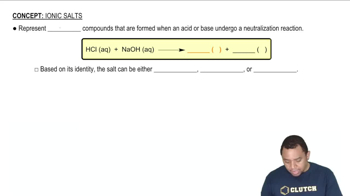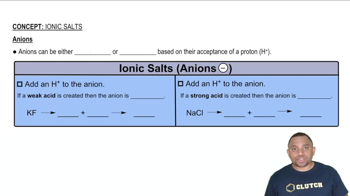Here are the essential concepts you must grasp in order to answer the question correctly.
Salt Hydrolysis
Salt hydrolysis is the reaction of a salt with water, leading to the formation of acidic or basic solutions. When a salt dissolves in water, its constituent ions can interact with water molecules, potentially altering the pH of the solution. The nature of the ions—whether they are derived from a strong or weak acid/base—determines if the solution will be acidic, basic, or neutral.
Recommended video:
Acidic and Basic Ions
Acidic ions are typically derived from weak acids and can donate protons (H+) to water, lowering the pH. Conversely, basic ions come from weak bases and can accept protons, raising the pH. In the case of Al(NO3)3, the aluminum ion (Al3+) can hydrolyze to produce H+ ions, indicating that the solution will be acidic.
Recommended video:
Anion Acidity and Basicity
pH Scale
The pH scale measures the acidity or basicity of a solution, ranging from 0 (very acidic) to 14 (very basic), with 7 being neutral. A pH less than 7 indicates an acidic solution, while a pH greater than 7 indicates a basic solution. Understanding the pH scale is essential for determining the nature of the solution formed by the dissolution of salts like Al(NO3)3.
Recommended video:

 Verified step by step guidance
Verified step by step guidance


